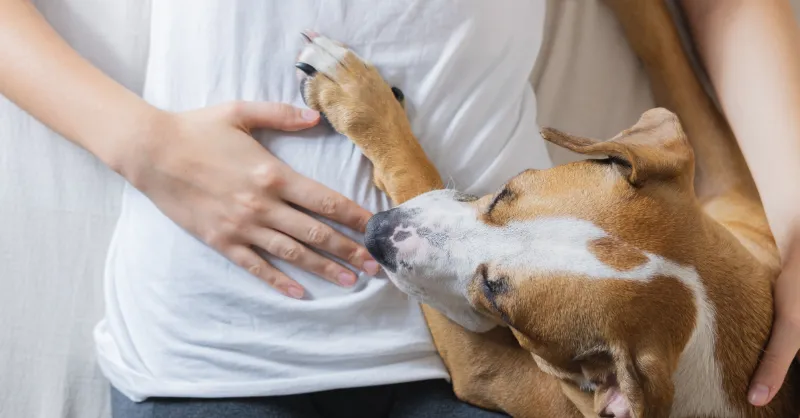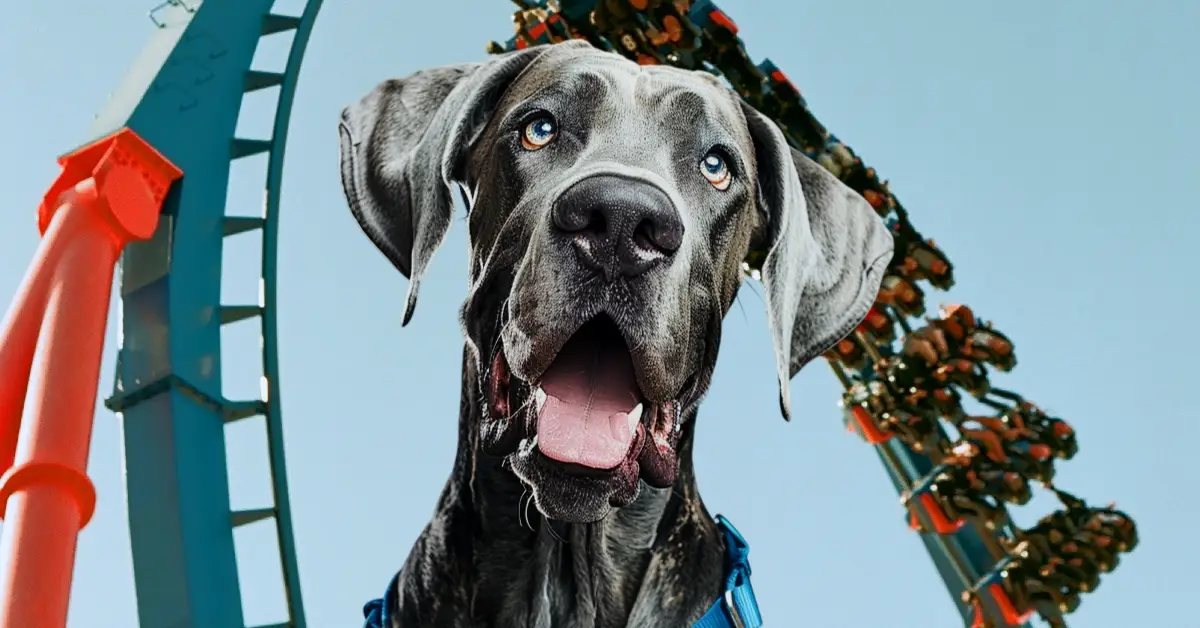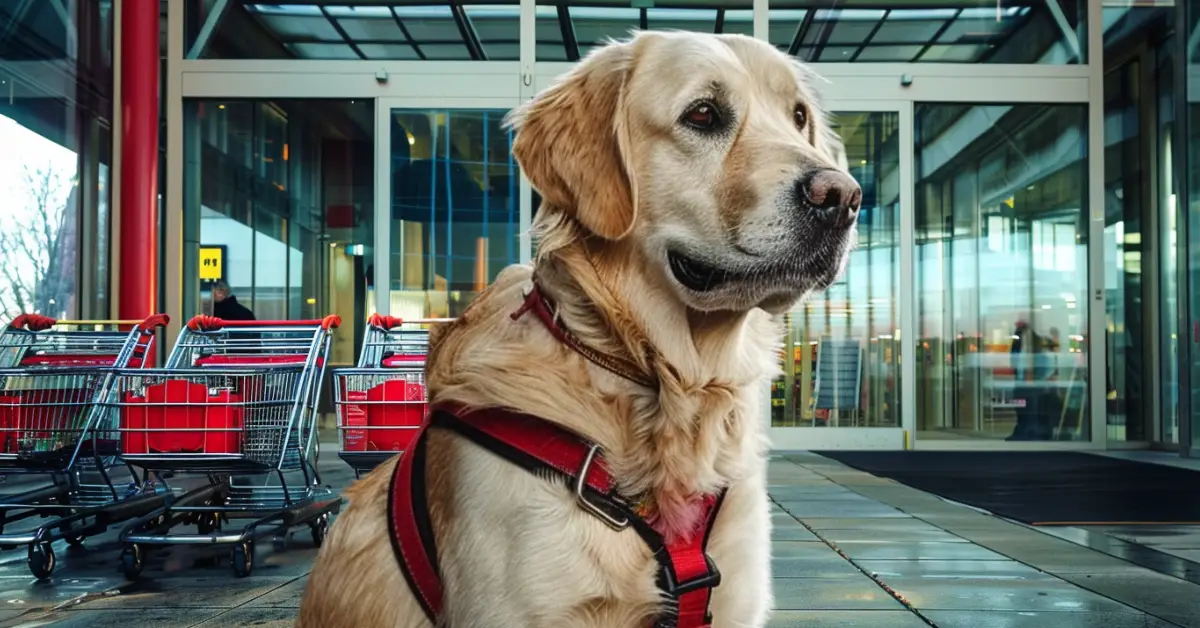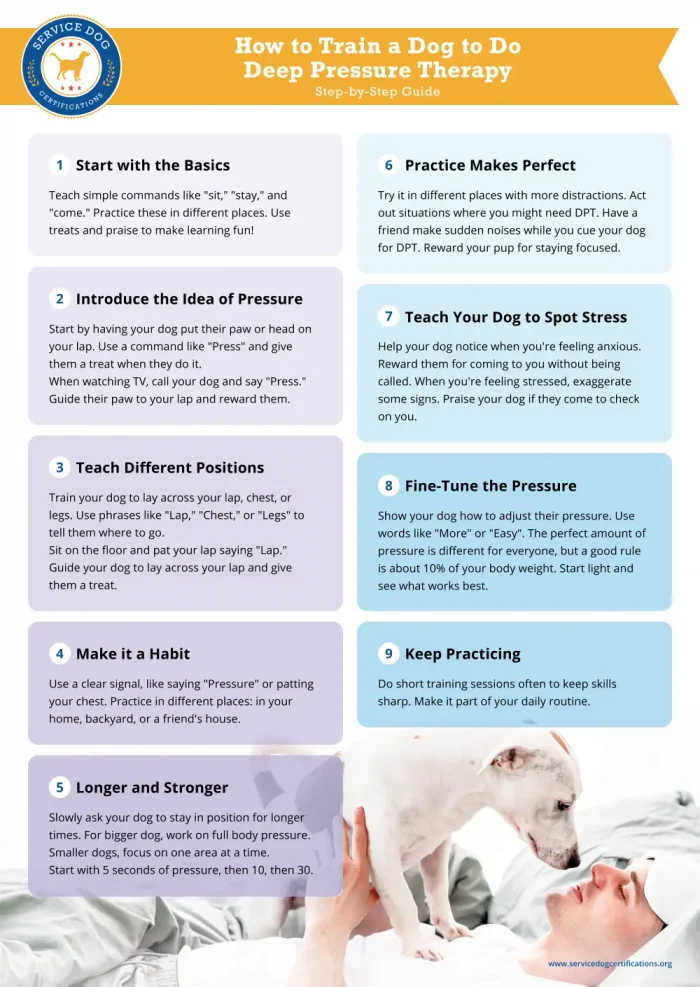How to Train a Dog to Do Deep Pressure Therapy

Deep Pressure Therapy (DPT) is a skill a dog can learn to qualify as a service dog to help people with mental health conditions, neurological disorders, and other disabilities. Training a dog for deep pressure therapy requires patience, consistency, and positive reinforcement to teach them to apply comforting pressure on cue, respond to signs of distress, and adapt their technique to the handler’s needs.
In this guide, we’ll show you how to train your dog to be a comforting companion using DPT. Don’t worry if you’re new to this — we’ll break it down into easy steps anyone can follow!
Deep Pressure Therapy Basics
There are many ideas as to why pressure therapy works for anxiety, from the feeling of a calming and safe space like a hug to the potential release of endorphins, serotonin, and dopamine. What we do know is countless studies like this one show pressure therapy does work for numerous people to calm anxiety.
The goal of applying pressure is to help a person with anxiety transition from fight-or-flight (managed by the sympathetic nervous system) to calm (which is managed by your parasympathetic nervous system). Anxiety service dogs can be trained to perform DPT, a learned task that can meet one of the requirements for service dog ownership.
How Does DPT Work?
When a dog applies pressure, it’s like flipping a switch in your body that turns on the “calm mode.” Here’s what happens:
- It helps your body relax instead of being in “fight or flight” mode.
- It can make your brain release feel-good chemicals.
- It helps you feel more connected to your body.
- The contact with your dog can make you feel safe and loved.
Think of it like a weighted blanket, but better because it’s your furry friend! Weighted blankets have been used as a form of deep pressure therapy to alleviate anxiety. Using a dog to provide that comforting touch has the same goal. Studies have also shown that touch interactions with dogs can lower the stress hormone cortisol and increase levels of the feel-good hormone oxytocin.
Training Your Dog for DPT: A Step-by-Step Guide
Now, let’s get to the fun part: training your dog! Remember, every dog learns at their own pace, so be patient and keep it fun.
Keep training sessions short and fun — 5 to 15 minutes is perfect. Always use positive feedback and treats. Never scold your dog for getting it wrong. If you get stuck, don’t be afraid to ask a professional dog trainer for help. Take breaks and play with your dog to keep them excited about learning.
- Start with the Basics
Teach your dog simple commands like “sit,” “stay,” and “come.” Practice these in different places, like your backyard or a quiet park. Use treats and praise to make learning fun! - Introduce the Idea of Pressure
Start by having your dog put their paw or head on your lap. Use a command like “Press” and give them a treat when they do it. When watching TV, call your dog over and say “Press.” Guide their paw to your lap and reward them. - Teach Different Positions
Train your dog to lay across your lap, chest, or legs. Use phrases like “Lap,” “Chest,” or “Legs” to tell them where to go. Sit on the floor and pat your lap saying “Lap.” Guide your dog to lay across your lap and give them a treat. - Make it a Habit
Use a clear signal, like saying “Pressure” or patting your chest. Practice in different places: in your home, backyard, or a friend’s house. - Longer and Stronger
Slowly ask your dog to stay in position for longer times. If you have a bigger dog, work on full body pressure. For smaller dogs, focus on one area at a time. Start with 5 seconds of pressure, then 10, then 30. Before you know it, your dog will be a pro at staying put! - Practice Makes Perfect
Try it out in different places with more distractions. Act out situations where you might need DPT, like pretending to be upset. Have a friend make sudden noises while you cue your dog for DPT. Reward your pup for staying focused on you. - Teach Your Dog to Spot Stress
Help your dog notice when you’re feeling anxious. Reward them for coming to you without being called. When you’re feeling a bit stressed, exaggerate some signs like deep breathing or fidgeting. Praise your dog if they come to check on you. - Fine-Tune the Pressure
Show your dog how to adjust their pressure. Use words like “More” for more pressure or “Easy” for less. The perfect amount of pressure is different for everyone. A good rule of thumb is about 10% of your body weight, but it’s really about what feels good to you. Start light and see what works best. Your dog will learn to read your cues! - Keep Practicing
Do short training sessions often to keep skills sharp. Make it part of your daily routine, like during TV time.
Share this image on your site
Who Can Benefit from a DPT Dog?
DPT dogs can be super helpful for many people, including those with:
- Anxiety
- PTSD (Post-Traumatic Stress Disorder)
- Autism
- ADHD (Attention Deficit Hyperactivity Disorder)
- Depression
For example, someone with anxiety might use their DPT dog during a stressful situation, like a crowded event. The dog’s pressure can help them feel grounded and calm.
Training Dogs of All Sizes
You don’t need a big dog to do DPT. Depending on the needs of the handler, different breeds can be the best for deep pressure therapy. Here’s how different-sized dogs can help with DPT:
Big Dogs (50+ lbs)
Big dogs are great for full body pressure because they can lay across your whole lap or chest. For example, a Golden Retriever can provide deep pressure by laying across your legs while you’re sitting on the couch.
Medium Dogs (25-50 lbs)
Medium sized dogs provide pressure to specific areas and might use their whole body length for maximum effect. A Cocker Spaniel could lay along your side when you’re lying down, providing comforting pressure.
Small Dogs (Under 25 lbs)
Smaller dogs are perfect for focused pressure on smaller areas and can use movement for added effect. A Chihuahua might walk back and forth across your chest or curl up tightly on your lap for concentrated pressure.
Remember, it’s not about how big your dog is, but how well they’re trained and how much they want to help you!
Training your dog to do deep pressure therapy can be a fun and rewarding experience for both of you. It might seem like a lot at first, but take it one step at a time, and you’ll be amazed at what your furry friend can learn.
Remember, every dog is different, and so is every person. The key is to find what works best for you and your pup. With patience, love, and lots of treats, you’ll have a skilled DPT partner in no time.
About the Author: The writing team at Service Dog Certifications is made up of folks who really know their stuff when it comes to disability laws and assistance animals. Many of our writers and editors have service dogs themselves and share insights from their own experiences. All of us have a passion for disability rights and animals.
Latest Posts

Can you bring a service dog to a museum?
Yes, you can bring your service dog to the museum! All the major U.S. museums welcome guests with service animals in accordance with the Americans with Disabilities Act (ADA). There are some areas, however, that might be off-limits. Here’s what you should know if you plan to spend a day at the museum with your […]

Read More

How to Bring a Service Dog to Six Flags Magic Mountain
Service dogs are welcome at Six Flags Magic Mountain so long as they are, according to Six Flags, “trained to do work or perform tasks for people with disabilities.” Of course, your dog must be housebroken and remain on a leash or harness and under your control while at the park — and the park […]

Read More

When Stores Can Refuse Your Service Dog
According to the Americans with Disabilities Act (ADA), service dogs should be allowed into any store most of the time. A store owner can legally exclude a service dog if they are actively growling, snapping at, or frightening customers, or if the dog is obviously out of the control of its owner. Ordinary behaviors — […]

Read More
